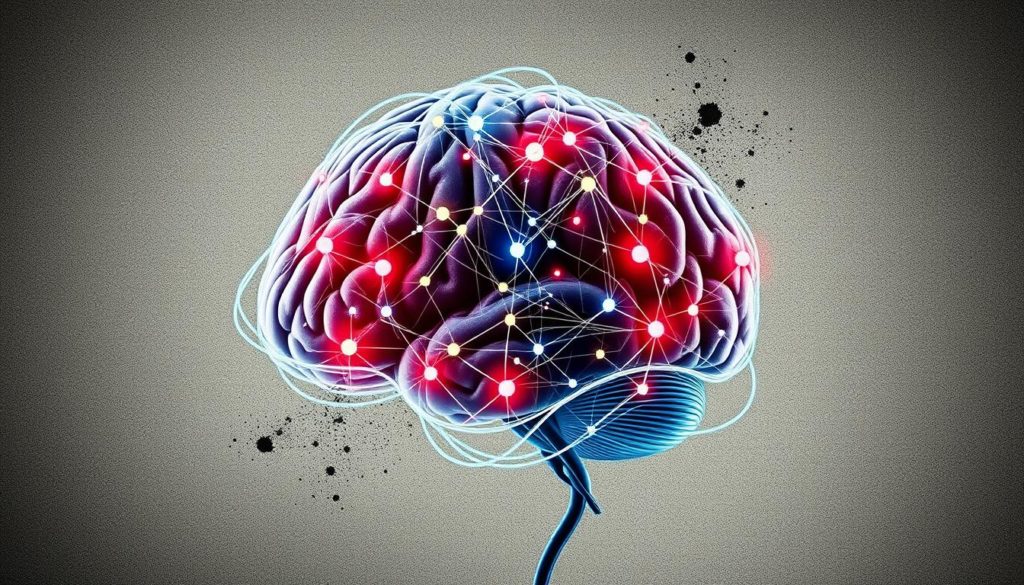Did you know over 6 million Americans live with Alzheimer’s? This fact makes finding effective treatments crucial. The new drug, lecanemab, brings hope. It slows down memory and cognitive decline significantly.
Lecanemab marks a new direction in treating Alzheimer’s. It focuses on the disease’s root causes, not just symptoms. This approach aims to better the lives of early-stage patients. It’s a promising time for Alzheimer’s care, filled with hope and optimism.
Understanding Alzheimer’s Disease
Alzheimer’s disease is a brain disorder that gets worse over time. It destroys brain cells, leading to memory loss and difficulty in thinking. One main cause is the buildup of harmful proteins in the brain.

What is Alzheimer’s Disease?
Alzheimer’s harms the brain areas that handle thoughts, memories, and language. People with it find daily tasks hard. This happens because of abnormal protein deposits in the brain.
Alzheimer’s vs. Dementia
Alzheimer’s and dementia are not the same. Dementia is a broad term for memory loss conditions that affect daily life. Alzheimer’s makes up to 80% of dementia cases. Not all who have dementia have Alzheimer’s. Knowing about Alzheimer’s helps tell them apart.
Latest Approved Alzheimer’s Medications
New treatments for Alzheimer’s bring hope to those affected. The MHRA and FDA have approved transformative therapies. Lecanemab, or Leqembi, stands out among these.
Lecanemab (Leqembi)
Lecanemab is now approved in several countries, a major step forward. It’s not just about managing symptoms. Instead, it slows the disease’s progress. This marks a critical advancement in Alzheimer’s treatment strategies.

Recent Approvals and Their Impact
The FDA and MHRA have given the green light to Lecanemab. This nod towards new treatments brings hope. It also emphasizes the vital role of continuous research. Achieving this milestone shows a strong commitment to changing Alzheimer’s management.
| Medication | Approval Body | Impact on Treatment |
|---|---|---|
| Lecanemab (Leqembi) | FDA, MHRA | Disease-modifying; slows Alzheimer’s progression |
| Another Med | MHRA | Symptom management |
The green light for Lecanemab and other new drugs is a big leap forward. It promises better treatments and a brighter future for Alzheimer’s patients.
Breakthrough Immunotherapies for Alzheimer’s
New treatments are being developed for Alzheimer’s, with immunotherapies leading the way. These methods, first used in cancer care, are now aimed at Alzheimer’s. They focus on amyloid plaques, thought to harm brain cells, bringing fresh optimism.
How Immunotherapies Work
Immunotherapies use the body’s immune system to fight Alzheimer’s. They create antibodies to target and clear out amyloid plaques, key to Alzheimer’s. This clearing might slow the disease’s advancement. There’s a push to improve these therapies, making them more effective with fewer side effects.
The Role of Amyloid Plaques
Amyloid plaques are protein build-ups that harm the brain’s nerve cells. They’re thought to interrupt cell work and lead to Alzheimer’s signs. The goal is to remove these build-ups to protect brain health and keep the mind sharp. Recent progress gives patients and their families new hope for tackling Alzheimer’s.
Alzheimer’s Treatments: Hope for Better Care
Alzheimer’s treatments are now on a path to offer more than just symptom relief. We’re moving towards care that also prevents the disease. These advancements are changing how we treat Alzheimer’s. They bring hope to patients and their families.
New therapies aim to tackle Alzheimer’s root causes. They want to slow its progression and help with thinking skills. This is different from old methods that only treat symptoms. These innovations could help maintain brain health longer and enhance life quality.
Disease-modifying treatments in trials show signs of success. They could turn Alzheimer’s from a steady decline to a manageable condition. This change is sparking optimism among everyone involved in Alzheimer’s care.
The table below shows how some new Alzheimer’s treatments compare to older ones:
| Therapy Type | Target | Benefits |
|---|---|---|
| Traditional Therapies | Symptomatic Relief | Short-term management of symptoms |
| Alzheimer’s Therapy | Underlying Disease Mechanisms | Potential to slow down disease progression |
| Disease-Modifying Treatments | Amyloid Plaques | Extended cognitive health and improved quality of life |
Research and new findings bring a fresh wave of hope. Millions affected by Alzheimer’s now have a brighter future in sight. By attacking the disease at its heart, these advanced methods are changing Alzheimer’s care forever.
Donanemab: A New Hope
Recent strides in Alzheimer’s research have introduced promising treatments. Donanemab, created by Eli Lilly, stands out. It has shown great promise in slowing Alzheimer’s disease.
Development and Trials
Donanemab’s trials have caught everyone’s attention. The TRAILBLAZER-ALZ2 trial slowed Alzheimer’s progression by up to 60% in some areas. Doctors and analysts are hopeful about these results. They represent a big leap forward in Alzheimer’s research.
The excitement grows with new trials. TRAILBLAZER-ALZ3 and TRAILBLAZER-ALZ4 aim to build on this success. They are testing Donanemab’s ability to delay or prevent Alzheimer’s.
Clinical Results and Expectations
The TRAILBLAZER-ALZ2 trial’s outcomes have sparked a lot of hope. Participants saw a slower decline in daily tasks, such as driving and handling money. These achievements highlight the treatment’s potential benefits for Alzheimer’s patients.
With FDA approval in process, Eli Lilly is optimistic about the future. The ongoing TRAILBLAZER trials aim to confirm Donanemab’s effectiveness and safety. Here are the main findings from these trials:
| Trial | Focus | Key Results |
|---|---|---|
| TRAILBLAZER-ALZ2 | Progression Slowing | Up to 60% Slowdown |
| TRAILBLAZER-ALZ3 | Delay/Prevention | Ongoing |
| TRAILBLAZER-ALZ4 | Validation & Safety | Ongoing |
Exploring Remternetug
Remternetug is a big step forward in fighting Alzheimer’s. Created by Eli Lilly, it’s a new kind of immunotherapy. It goes after amyloid plaques, which are key in Alzheimer’s. The drug aims for better safety and easier use.
How Remternetug is Administered
The way Remternetug administration works is pretty cool. It’s easier for patients and has fewer side effects. It’s given through a simple shot under the skin, not through an IV. This means less risk and it’s easier to keep using it.
Clinical Development and Safety
Remternetug is now being tested in big trials to see how well it works and how safe it is. These Phase 3 trials are super important. They help us know it can really help with Alzheimer’s symptoms. Early results look promising. They show it might clear amyloid plaques better than other drugs. But, keeping an eye on risks like brain issues is key.
Innovative Approaches: Blarcamesine
Blarcamesine, by Anavex Life Science Corp., is a new way to fight Alzheimer’s disease. It works on sigma-1 receptors to stop protein misfolding. This is key in stopping amyloid plaque from forming.
Mechanism of Action
The main role of Blarcamesine action is to turn on sigma-1 receptors. This stops proteins from folding the wrong way. It’s crucial in managing harmful proteins in Alzheimer’s disease.
It also protects the mitochondria. This makes the drug a comprehensive strategy against Alzheimer’s.
Latest Trial Results
Recent tests show Blarcamesine might reduce cognitive decline by 25%. But, improvements in daily living activities weren’t seen. Still, Anavex seeks marketing approval in Europe.
Also, Blarcamesine could help with Parkinson’s disease dementia. It is under study for this potential now.
Importance of Early Diagnosis and Intervention
Spotting Alzheimer’s early and starting intervention quickly is key to managing it well. Finding signs early can lead to more effective treatments and improve lives. This approach is critical for patient care.
Recognizing Early Symptoms
Knowing the early symptoms of Alzheimer’s is essential. Signs like trouble with usual tasks, forgetting things, and problem-solving issues can signal the start of Alzheimer’s. Acting on these symptoms early can help stop more memory loss.
Benefits of Early Treatment
Starting Alzheimer’s treatment early has many advantages. It can maintain thinking skills longer and slow symptom worsening. People like Lori Weiss in clinical trials for new treatments, such as Donanemab, show promising signs of a better life with early care.
| Factors | Early Diagnosis | Late Diagnosis |
|---|---|---|
| Symptom Management | More Effective | Less Effective |
| Quality of Life | Higher | Lower |
| Treatment Options | Wider Range | Limited |
| Family Preparedness | Better Prepared | Less Prepared |
Support Systems for Alzheimer’s Patients
Handling Alzheimer’s is tough, but Alzheimer’s support systems are key for patients and their families. They offer help, community feeling, and key support. This makes managing the disease easier.
Important are memory care programs and Alzheimer’s support groups. Caregivers and patients find specialized care in memory care programs. These programs help keep the brain active and safe.
Memory Care Programs
Memory care provides specific care for Alzheimer’s individuals. They include activities to help with memory and brain health. They also give caregivers a break, ensuring loved ones are in a safe place.
Alzheimer’s Support Groups
Being part of Alzheimer’s support groups helps patients and caregivers. It’s a place to share stories, get advice, and find understanding. The Alzheimer’s Association offers many resources and support groups. They offer educational materials, practical tips, and ways to cope.
Using resources from the Alzheimer’s Association like programs and groups helps families greatly. They provide necessary aid for everyday life.
Future Directions in Alzheimer’s Research
The future of Alzheimer’s research is bright with promise. We are on the verge of new treatments that focus on the disease’s root causes. The journey in cancer research shows us what might be possible, sparking hope for big advancements in understanding Alzheimer’s. Researchers believe by getting to know how Alzheimer’s starts, they can create better ways to fight it.
The complexity of Alzheimer’s disease is now fully acknowledged. It’s clear we need a range of ways to treat it, similar to how cancer treatment has evolved. Future Alzheimer’s treatments are expected to include different drugs, lifestyle changes, and maybe gene therapies. Together, they will target different parts of the disease.
Currently, Alzheimer’s research is focused on catching the disease early and finding treatments that work for the individual. Scientists are using new tech and ideas like artificial intelligence and genomics to find unique disease markers. They’re working towards medicines that are made just for one person. The aim is to change how we tackle Alzheimer’s, offering new solutions and hope to those affected by it.
FAQ
What is Alzheimer’s Disease?
Alzheimer’s disease happens when brain cells break down. This leads to losing memory and having trouble thinking.
How is Alzheimer’s different from Dementia?
Dementia covers many brain problems that hurt daily life. Alzheimer’s is a common type of dementia, linked to amyloid proteins in the brain.
What are the latest approved Alzheimer’s medications?
The latest medication, Lecanemab (Leqembi), changes how we treat Alzheimer’s. It’s a big step forward.
How do immunotherapies work for Alzheimer’s?
Immunotherapies focus on removing amyloid plaques in the brain. This helps slow down the disease.
What role do amyloid plaques play in Alzheimer’s?
Amyloid plaques are harmful protein clusters in the brain. They are a key reason brain cells die in Alzheimer’s.
What promising outcomes have been seen from Donanemab trials?
The TRAILBLAZER-ALZ2 trial showed Donanemab could slow down Alzheimer’s by up to 60% in some areas. This brings a lot of hope.
How is Remternetug administered, and what are the safety considerations?
Remternetug could be given as a shot under the skin. This could make it easier to use and reduce side effects. Phase 3 trials are looking into how safe and effective it is.
What is the mechanism of action for Blarcamesine?
Blarcamesine works by turning on sigma-1 receptors. This helps stop protein problems and damage to cell powerhouses, key in fighting amyloid buildup in Alzheimer’s.
Why is early diagnosis and intervention important for Alzheimer’s?
Finding Alzheimer’s early means treatment can start sooner. This can help keep thinking clearer for longer, helping those affected stay independent.
What support systems are available for Alzheimer’s patients?
Alzheimer’s patients can find help through memory care programs and support groups. These resources offer support and information to both patients and families.
What are the future directions in Alzheimer’s research?
Research is heading towards treatments that directly target Alzheimer’s biology. The goal is to find complex solutions for this complicated disease.


